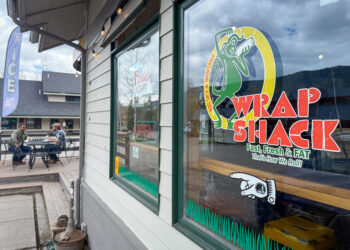By Mel Crichton EBS COLUMNIST
It’s said that death is the great equalizer. It doesn’t care if you are rich or poor, live in a big home or in a shack. It’ll get you just the same. Death is not alone in the equal opportunity business—wildfire is just as equitable. And like a tornado that always seems to aim for mobile homes, it hits hardest where people are least prepared. Wildfire and death work together, and nobody wins.
Our town of Big Sky is more likely than 96% of America to experience a wildfire. It’s coming, we just don’t know when. But we can be prepared and maybe rob wildfire of a big win. Part of that preparation we’ve already covered—preparing your home for wildfire—in Fire Adapted Big Sky’s March seminar on YouTube and our first Wildfire Wire column. Now let’s talk about staying alive.
We’ve seen news videos from other communities of long lines of scared residents fleeing wildfire. We’ve heard the statistics about hundreds of homes destroyed, dozens of lives and many more futures lost to fires in communities like Paradise, California in 2018 and Lahaina, Maui, Hawaii in 2023. But preparation for wildfire could have reduced those grim numbers, including homesite mitigation, evacuation readiness and dealing with dangerous smoke levels.
Those survival and resilience topics will be discussed in another free public event hosted by Fire Adapted Big Sky at 6 p.m. on June 23 at the Warren Miller Performing Arts Center. Our event will be streamed on our YouTube channel as well. Public servants will speak on preparing for wildfire evacuation and dealing with smoke.
Here’s a preview of the material.
When the U.S. Forest Service’s fire danger arrow—on signs located near Big Sky Resort, and the intersection of U.S. Highway 191 and Montana Highway 64,—points to “HIGH” or beyond, it’s time to get your go-kit ready and keep your cell phone on in case the county determines that a fire is approaching. Before an evacuation notice is issued, it’s a good time to gas up the car and pack the go-kit, because you may have only 20 minutes to get out of Dodge. By leaving before the fire is on your doorstep, you improve your survival odds.

What’s the best way to receive emergency alert notifications? Sign up for Gallatin County alerts on Everbridge, pack your go-kit, practice evacuations with your family, know how to prepare your home when you leave, know your potential evacuation routes, and know where you can shelter in place. Be sure you identify neighbors who may need help in evacuation and ensure that someone will help them. Much of this info is in the Big Sky Wildfire Action Guide, available on the Big Sky Wildfire Hub and on the Fire Adapted Big Sky Resources Facebook page.
On June 23, we will also discuss the impacts of smoke from far-away fires and how health-compromised residents can deal with it. Part of the solution is sheltering indoors with an air filtration unit, available either commercially or homemade—we’ll demonstrate how to make your own indoor air filter at the next event. Plus, until June 30, NorthWestern Energy is offering a $100 rebate on your purchase of a commercial HEPA air purifier unit.
You can ask questions on our Facebook page, but even better, attend in-person to ask the experts. You can also seek out your neighborhood ambassador or “NA”—find the list on the Facebook page.
During June, our NAs will be working with their neighbors on one-day special projects to reduce wildfire risk to homes. And if you want a home to return to in the case of a fire, watch the March presentation and visit our Facebook page for more info. You should be hardening your home as soon as possible. Some work takes a day, some work takes weeks. Request an inspection—there’s a link on the Big Sky Wildfire Hub—and hire a contractor before they are all booked.
We’re all in this together. If we are prepared and willing to help each other, we will all survive a potential catastrophic event.
Mel Crichton acts as neighborhood ambassador coordinator for Fire Adapted Big Sky. He may be reached at kj9c@comcast.net.













